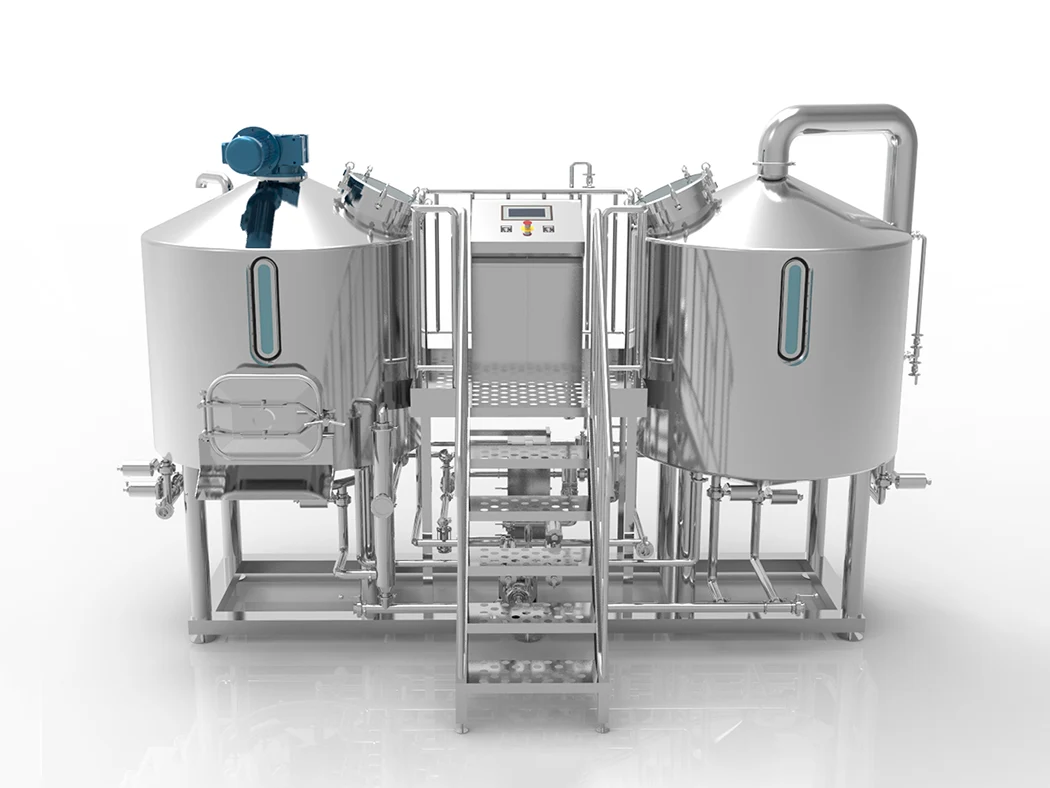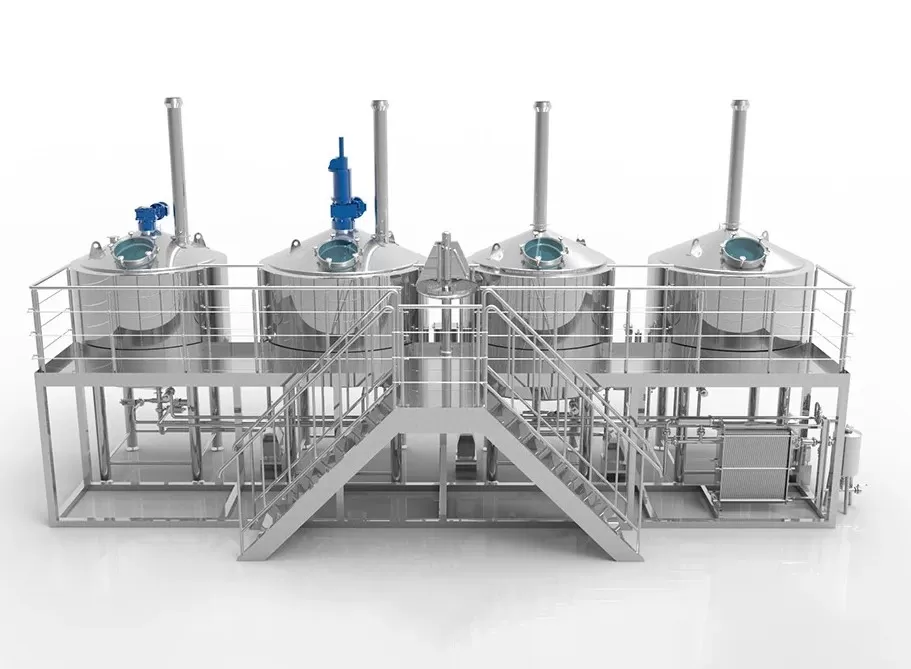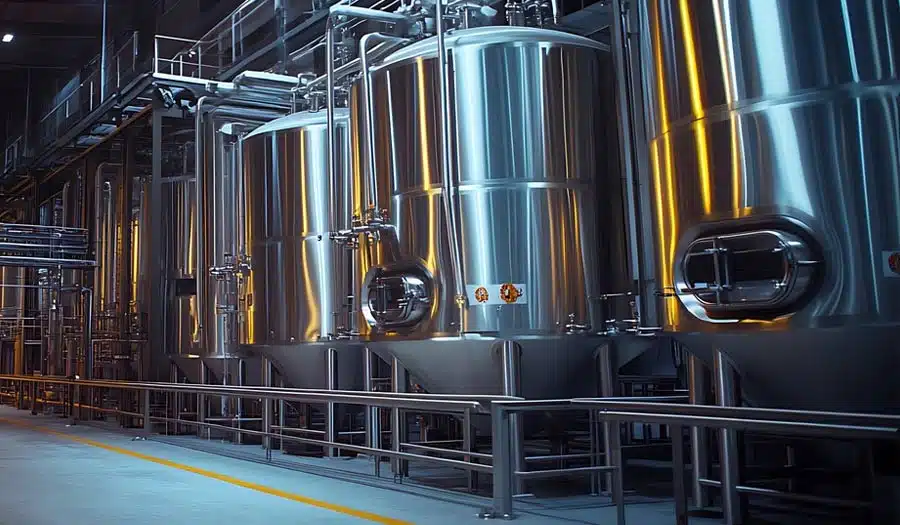In any brewery, if the mashing system is considered the “heart,” then the fermentation system is undoubtedly the “soul.” At the center of this system lies the most critical piece of equipment—the brewery fermentation tank. From the early stages of brewery planning, it becomes clear that fermentation tanks are far more than just simple vessels. They play a crucial role in defining beer flavor, ensuring quality consistency, and enabling production flexibility. This guide, from the perspective of brewery clients and drawing on real-world experience from collaborations between Micet Group and brewery equipment manufacturers, explores the role of fermentation tanks within the brewing system, including selection criteria, installation layout, operational maintenance, and future scalability.
Why Are Brewery Fermentation Tanks Called the “Soul” of Brewing?
Fermentation is the process where yeast converts the sugars in wort into alcohol and carbon dioxide. It is also the key stage that determines beer taste, body, and nuanced flavor. After visiting numerous established breweries, we’ve found that regardless of the size of the facility or complexity of the process, fermentation tanks always occupy the central space and represent a major portion of the overall investment.
- The Key Bottleneck That Determines Production Capacity:The mashing system can be reused multiple times per day, but once a fermentation tank is filled, a single batch typically occupies it for 7–21 days or even longer. Thus, the number and volume of fermentation tanks directly determine the brewery’s annual production capacity.
- Ensures Flavor Consistency:A scientifically designed fermentation tank with precise temperature control ensures batch-to-batch flavor stability. It minimizes uncontrollable variables, allowing brewers to create consistently high-quality beer.
- Enables Craft Beer Diversity:Whether brewing Ale, Lager, sour beers, barrel-aged styles, or non-alcoholic options, each style requires specific fermentation conditions. High-quality fermentation tanks provide a solid foundation for a diversified product strategy.
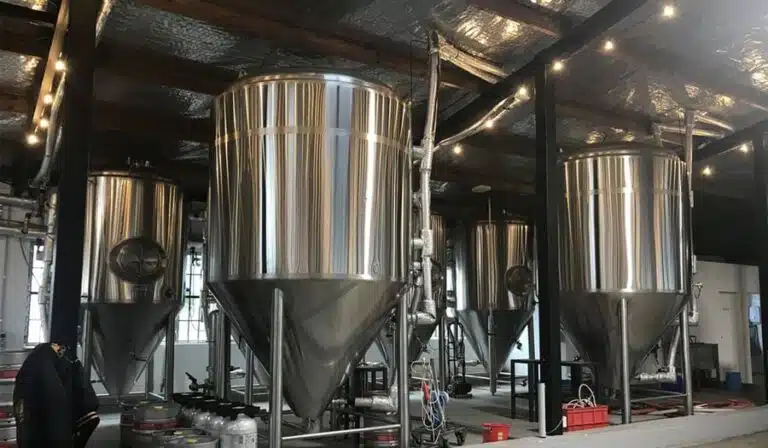
What Did We Consider When Choosing the Right Fermentation Tanks for Our Brewery?
Fermentation Tank Capacity Design
Common fermentation tank capacities range from 500L, 1000L, 2000L, to 5000L. We selected tank sizes based on the batch output of our mashing system. Considering the relatively long fermentation cycle, we adopted a “double-batch tank” strategy: for a 1000L-per-batch mashing capacity, we use 2000L fermentation tanks. This allows us to combine two mash batches into one fermentation cycle—improving efficiency while reducing equipment footprint and energy consumption.
Material and Craftsmanship Requirements
We chose SUS304 stainless steel for its durability and hygiene. The inner surface is mirror-polished (Ra ≤ 0.4μm) for easy cleaning, while the outer surface is brushed for a clean, professional appearance. Each tank is equipped with a complete set of features to ensure safe and efficient fermentation:
- Cooling jacket
- Temperature probe
- CIP spray ball
- Safety valve
- Pressure gauge
- Sampling valve
- Drain outlet
- Air vent
Precision of the Temperature Control System
Since our brewery focuses mainly on lager-style beers, which are highly sensitive to temperature, the supplier equipped our tanks with an independent glycol circulation system and wrap-around cooling jackets. This setup ensures temperature control within ±0.1°C for each tank, significantly improving fermentation consistency.
Tank Shape and Structural Design
We use vertical conical-bottom tanks with a 60° cone angle, which supports effective yeast sedimentation and recovery, as well as easy draining and CIP cleaning. The tank tops are openable, allowing for dry hopping and real-time observation of fermentation. A sight glass and level gauge are positioned at the front for operators to easily monitor internal conditions at any time.
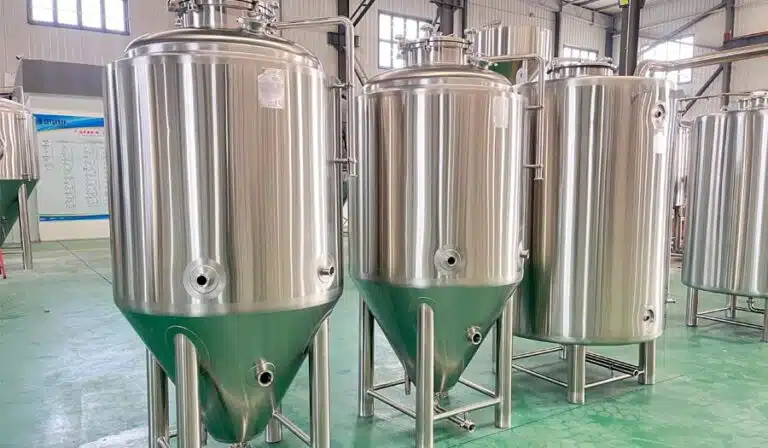
How to Effectively Lay Out Fermentation Tanks in a Brewery
Define Your Brewery’s Positioning: Foundation for Fermentation Tank Layout
Before planning the layout of fermentation tanks, it’s crucial to clearly define your brewery’s overall positioning. Factors such as the number, size, arrangement, and placement of the tanks must align with your production capacity, beer styles, brewing frequency, and available space. Are you building a small craft brewery or a large-scale industrial facility? Are you primarily brewing ales, lagers, or a mix of styles? Is the operation batch-based or focused on continuous high-efficiency output?
Only after setting clear goals—such as annual production targets, process design, budget limitations, and future expansion needs—can you create a fermentation tank layout that fits your strategic vision. This prevents costly future adjustments caused by capacity upgrades or product diversification.
Follow the Brewing Workflow: Position Fermentation After Mashing and Cooling
Fermentation tank layout should strictly follow the beer production process—from mashing to fermentation to packaging. This ensures minimal material transport distance, maximum efficiency, and optimal energy usage.
Fermentation areas should be placed directly after the brewhouse, and logically connected to the cooling system and packaging line, forming a seamless flow: wort → fermentation → finished beer packaging. A well-designed layout reduces unnecessary handling, shortens piping, minimizes temperature loss and contamination risk, and ensures integration with the CIP system.
Where space allows, use the longitudinal depth of the facility to create functional zones in the order of “mashing – fermentation – conditioning – packaging,” allowing for smooth and efficient transitions between each stage.
Use Modular Design: Reserve for Expansion and Maintenance Access
Fermentation tank layouts must not only serve current needs but also accommodate future growth. A modular layout is a smart, flexible solution. Arrange tanks in groups with dedicated operation aisles and pipeline interfaces between groups. This leaves room for adding more tanks or upgrading systems later.
Modular design also supports standardized installation, systematic management, and easier inspection and maintenance. Infrastructure like glycol lines, CIP loops, and drainage should use standardized connections and capped outlets, ready for future connections.
Especially for breweries unable to invest in full capacity from the start, this approach minimizes future disruption when expanding equipment.
Maximize Vertical Space: Leverage the Height of Fermentation Tanks
Most fermentation tanks are vertical conical-bottom vessels with heights between 3–6 meters. Brewery construction or renovation must account for sufficient clear ceiling height. Where feasible, install multi-level platforms or gravity-assisted systems to support vertical workflows:
- Top level: raw material loading or dry hopping
- Middle level: observation and control
- Bottom level: waste drainage and cleaning
This setup saves floor space, uses gravity to assist flow, and reduces energy consumption. Upper platforms can also house control panels, breather and safety valves for centralized management. Lower levels can manage glycol connections, drainage, and CIP returns, keeping the floor clear and safe. Overall, vertical integration improves spatial efficiency, operational convenience, and safety.
Standardize Piping Systems: Boost Efficiency and Safety
Fermentation tanks rely on a comprehensive set of systems—cooling, cleaning, gas supply, and monitoring—that should be centrally planned and laid out:
- Cooling lines should use a main trunk with branches, evenly distributing glycol to each tank for stable temperature control.
- CIP systems need dedicated circulation loops, with spray balls and nozzles placed inside the tank top to avoid dead zones and contamination.
- Utility pipelines (compressed air, CO₂, nitrogen, hot water) should include clear labeling and isolation devices at connection points to ensure safe operation.
- A centralized piping system improves energy efficiency, enhances control precision, and simplifies maintenance, reducing risks of pipeline confusion or interface conflicts.
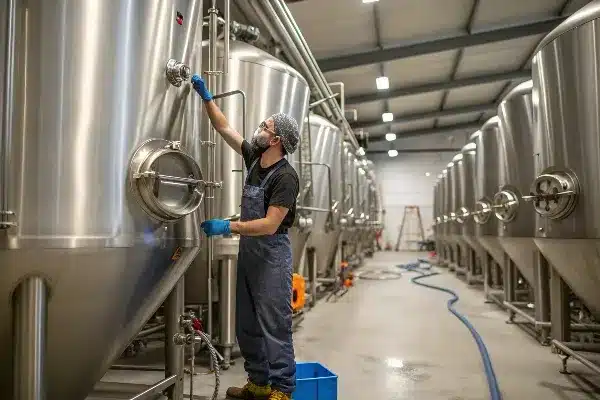
Plan Operator Movement Paths: Ensure Routine Access and Emergency Safety
Fermentation tanks are high-use zones, so their layout must support both routine operation and emergency movement. Allocate sufficient working space in front of each tank for:
- Sampling
- Waste discharge
- Valve operation
- Viewing through sight glasses
Maintain unobstructed aisles between tanks for regular inspections. Control panels and displays should be placed within easy line of sight, avoiding frequent cross-traffic through pipe-heavy zones. Include fire extinguishers, emergency exits, and warning lights in the movement path design to ensure safe evacuation in emergencies.
If the brewery is also open to visitors, provide separate tour paths using glass partitions or overhead walkways to isolate public, operator, and material flows—ensuring both safety and a good viewing experience.
Choose the Right Layout Pattern Based on Facility Type
The physical structure and dimensions of your brewery will dictate the best fermentation tank layout:
- Single-row straight layout: Ideal for narrow or small-scale breweries; simple and easy to pipe but limited for future expansion.
- Double-row symmetrical layout: Suitable for mid-size and larger breweries; central aisle with mirrored tank rows, easy to standardize and scale.
- U-shaped or I-shaped layout: Designed for high space efficiency and process compactness; often used in multifunctional breweries where brewing and packaging zones are integrated.
The choice of layout should consider building dimensions, tank specifications, brewing process, and operator habits, aiming to achieve the most functional zoning and workflow within limited space.
Key practices in operation and maintenance: Keep the fermentation tank "healthy"
Regular CIP cleaning: Ensure the cleanliness of the inner wall and yeast activity
The CIP cleaning system is a key equipment to maintain the cleanliness of the fermentation tank. It is recommended to carry out a complete CIP procedure after each batch of fermentation, including alkaline washing, hot water washing, acid washing and final sterile water washing, to ensure that there are no residual organic matter and microorganisms on the tank wall. Pay special attention to whether the spray ball can fully cover the inner wall of the tank, and regularly check whether the spray uniformity and pump station pressure meet the standards. For tanks that are used frequently, samples should be taken every week to check the risk of residual microorganisms or yeast contamination, and the cleaning fluid should be replaced regularly to avoid failure.
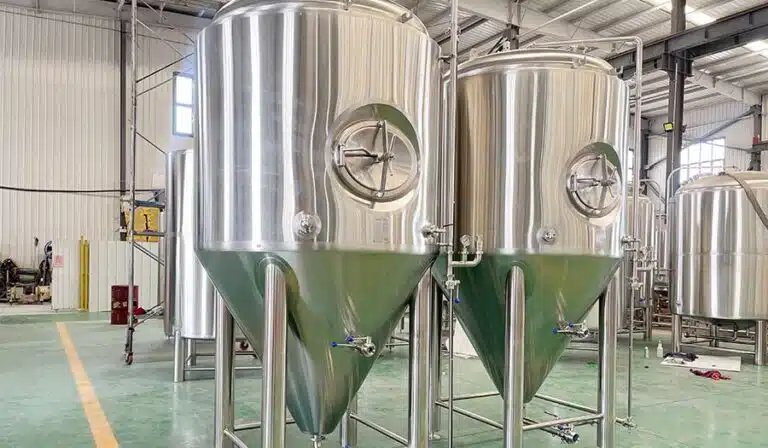
Keep the temperature control system running accurately: stabilize the yeast metabolic environment
The fermentation tank has extremely high requirements for temperature control accuracy, especially for low-temperature fermented Lager or special brewing processes that require strict temperature control. The refrigerant circulation system needs to maintain stable pressure and no leakage, and the temperature control probe should be calibrated regularly to ensure that the temperature difference fluctuation does not exceed ±0.2℃. In high temperatures in summer or severe cold in winter, special attention should be paid to the operating status of the refrigeration station and the refrigerant flow rate to prevent the system from being overloaded and causing temperature control failure. In addition, it is recommended to conduct a full system temperature control inspection once a year and replace aging pipes or joints in time.
Maintenance of key components: valves, seals, and respirators cannot be ignored
Various valves (such as exhaust valves, sampling valves, and feed valves) and seals of fermentation tanks are prone to aging or loosening under long-term high pressure and temperature difference environments. If they are not replaced in time, they may cause risks such as leakage and bacterial invasion. It is recommended to conduct a comprehensive inspection of all valves and seals every three months, and record the service life to achieve early warning and periodic replacement. In addition, the respirator on the top of the tank is the key to controlling the pressure and air exchange in the tank. It must be kept unobstructed and cleaned at least once a month to ensure its normal filtering function.
Establish a digital inspection system: improve the response speed of problems
As the digitalization level of breweries continues to improve, more and more companies use PLC control systems or SCADA monitoring systems to monitor the operating status of fermentation tanks in real time. It is recommended to set key nodes such as temperature alarms, pressure abnormalities, and CIP cleaning progress reminders in the control system, and push them to operators in a timely manner to improve the response speed. At the same time, a standardized inspection system is established, including daily temperature records, weekly cleaning verification, and monthly structural inspections, to make maintenance work more transparent and traceable.
Focus on operation training and safety management: prevent human errors from interfering with fermentation
Efficient equipment also requires the cooperation of a professional operation team. Enterprises should regularly conduct fermentation tank operation training, covering tank opening and closing sequence, valve identification, abnormal handling and other contents. Differentiated training plans should be formulated for personnel in different positions (such as winemakers, maintenance workers, and electrical technicians). In particular, new employees must pass a simulated operation assessment before taking up their posts to ensure standardized operation. In addition, the fermentation area must be equipped with an emergency power outage switching mechanism and a pressure surge relief plan to fully ensure production safety.
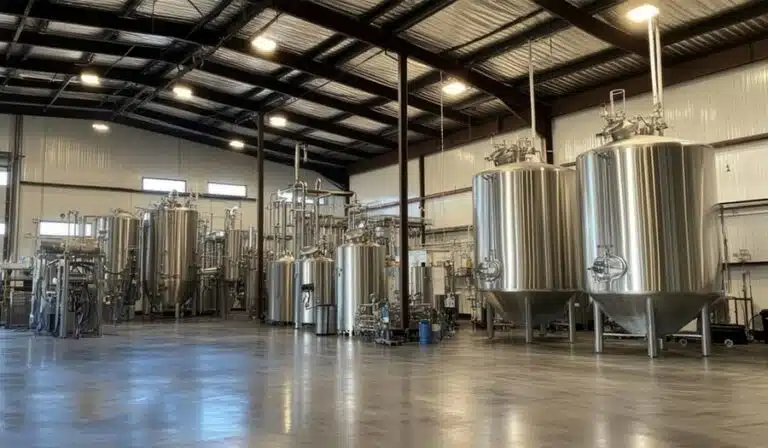
Planning for the Future: A Scalable Fermentation Tank System
|
Dimension |
Strategy at Current Stage |
Approach for Expansion Stage |
Notes |
|
Tank Arrangement |
Modular side-by-side layout with reserved aisle space |
Expand by adding modules without modifying existing system |
Recommend reserving one full tank space or aisle every two groups |
|
Foundation Structure |
Foundation blocks pre-installed with anchor bolt holes |
New tanks can be installed directly on pre-set blocks |
Minimizes civil work and production downtime later |
|
Cooling System |
Main coolant lines sized for double capacity, with capped outlets |
Connect new tank branches by opening capped ends |
Stainless steel or food-grade PPR materials recommended |
|
CIP Cleaning System |
CIP circulation pipeline with extra reserved ports |
New tanks directly connected to existing CIP system |
Avoids the need for separate CIP units, centralized control |
|
Control System |
PLC cabinet with reserved I/O ports for future tanks |
Activate new tank control logic via software setup |
Maintains consistency in control and data monitoring |
|
Electrical Wiring |
Cable trays and control panels with extra space |
New motors, sensors wired through existing channels |
Follow electrical layout standards to reduce interference |
|
Operation Space |
Sufficient access space for operators and maintenance |
Maintains ergonomic design even after expansion |
Recommended spacing ≥ 1000mm for safe and easy access |
|
Drainage System |
Floor drainage designed for future maximum load |
Simply extend drain hoses or add drain ports |
Each tank drains independently to avoid cross-contamination |
|
Safety Equipment |
Fire extinguishers and emergency buttons pre-installed for maximum capacity |
No need to relocate, just perform periodic checks |
Ensure all areas have clear evacuation signage |
|
Investment Strategy |
Prioritize infrastructure and pipelines; add tanks in phases |
Eases upfront investment pressure, ensures smooth scaling |
Slightly higher total cost, but much greater flexibility |
Creating a truly "growable" brewing space for customers
As a manufacturer that has been deeply engaged in beer brewing equipment for many years, Micet has always believed that an excellent brewery must not only meet current production needs, but also have the flexibility to grow in the future. In the layout and construction of the fermentation system, we not only pay attention to the performance and quality of the equipment itself, but also pay attention to how to help customers achieve “seamless upgrades” in future expansion through reasonable space planning, interface reservation and modular design. The placement of each fermentation tank and the extension direction of each pipeline are our common commitment to the future with our customers.

